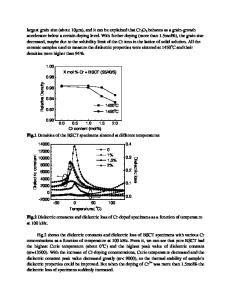Enhanced dielectric properties of highly dense Ba 0.5 Sr 0.5 TiO 3 ceramics via non-toxic gelcasting
- PDF / 1,650,923 Bytes
- 9 Pages / 595.276 x 790.866 pts Page_size
- 47 Downloads / 313 Views
Enhanced dielectric properties of highly dense Ba0.5Sr0.5TiO3 ceramics via non-toxic gelcasting Jie Xu1,2,* , Shuhang Liu1, Yujian Wang1, Yiting Guo1, Jia Zhao1, Haixue Yan2,3, and Feng Gao1,2 1
State Key Laboratory of Solidification Processing, MIIT Key Laboratory of Radiation Detective Material and Device, School of Material Science and Engineering, Northwestern Polytechnical University, Xi’an 710072, China 2 NPU-QMUL Joint Research Institute of Advanced, Materials and Structure, Northwestern Polytechnical University, Xi’an 710072, China 3 School of Engineering and Materials Science, Queen Mary University of London, London E1 4NS, UK
Received: 29 June 2020
ABSTRACT
Accepted: 24 August 2020
In this paper, a non-toxic water-soluble copolymer of isobutene and maleic anhydride (Isobam) was used for gelcasting of Ba0.5Sr0.5TiO3 (abbreviated as BST50) ceramics as both dispersant and gelling agent. The rheological properties and gelation behavior of BST50 suspensions have been investigated. BST50 suspension with 54 vol% solid loading and 0.1 wt% Isobam was optimized for the gelcasting process. Complex-shaped green bodies were prepared with homogeneous microstructure without large defects. BST50 samples sintered at 1500 °C were processed at a high relative density of 99.6%. The sample possessed a high dielectric tunability of 22% (30 kV/cm) and tand of 0.006 (1 kHz) which is decreased by 70% compared with that of dry-pressed samples. The present method has great potential in the preparation of other functional ceramics with complex shape and enhanced performance.
Ó
Springer Science+Business
Media, LLC, part of Springer Nature 2020
1 Introduction Gelcasting is a novel colloidal process that can prepare near-net-shape ceramic parts with high green strength that can be directly machined [1–3]. In the early study of gelcasting, acrylamide monomer was used as a gelling agent. The entire gel system is based on a free radical polymerization reaction, and the polymerization reaction with the air-green body interface is terminated due to the presence of oxygen (oxygen inhibition effect [4]), resulting in the peeling
Address correspondence to E-mail: [email protected]
https://doi.org/10.1007/s10854-020-04336-0
of the green body surface. Oxygen inhibition can be prevented by in an inert atmosphere, but introduction of an inert gas increases production costs. To solve the problem of oxygen inhibition, water-soluble polymers (polyacrylamide, polyethylene glycol) were added to the suspension which could be operated in the air without surface exfoliation [5–7]. Later, epoxy resin-based gelcasting was developed with epoxy resin as a gelling agent and a hardener as a crosslinking agent [8–10]. The other problem with the acrylamide-based gelcasting system is that its
J Mater Sci: Mater Electron
neurotoxicity is harmful to human body and environment [4]. To avoid this problem, some researchers have studied natural polymers, such as proteins, polysaccharides, gelatin and starch, etc. [11–14]. Unfortunately, the strength of the
Data Loading...











